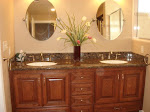I've been in the interior design business for just about 8 years, and one of the most common questions clients ask me is, "How do I know what colors to choose??"
Choosing colors for your home can seem overwhelming. But knowing a few facts about color can help you create a winning decorating plan. First, some color basics. You probably remember from Kindergarten that the three primary colors on the color wheel are red, yellow and blue? And secondary colors are green, orange and violet, which are created by combining the three primary colors. Those colors can then be mixed in different combinations to create more colors such as red-violet, yellow-green, and blue-green.
You may also remember that colors can also be described as “warm” or “cool”. Reds, yellows and oranges are considered warm, while blues, greens and violets are cool colors. This is important because warm colors often make rooms feel cheerful and lively, while cool colors exude a tranquil, restful feeling. Warm colors make the walls seem to advance toward you, while cool colors make the walls recede away from you.
Next one must consider a color's value, or, in other words, how light or dark a color is. Light colors reflect a lot of light. Dark colors absorb a lot of light.
Also consider a color's intensity. The closer the color is to the pure color, the more intense it is. For instance, bright lemon yellow is higher in intensity than soft butter yellow.
What does all of this mean for your home? Well, it all depends on the look you are trying to achieve. If you want to make a room seem more spacious, you should try using light, low-intensity, cool colors. And to make a room seem cozier and more intimate, you should use dark, high intensity, warm colors. That said, I don't want to discourage you from choosing dark colors for small rooms. If the room is already on the small side, why fight it? Dark colors add a lot of rich ambiance to a space.
Then there are color schemes. Color schemes are referred to in terms of the color wheel. For example, an analogous color scheme features colors that are next to each other on the color wheel. My daughter’s room is decorated in mint green, lavender and light blue—an analogous color scheme.
A complementary color scheme utilizes colors that are on opposite sides of the color wheel. This color scheme also appears in nature-- think of a beautiful sunset with blue sky accented by the flaming orange sun, or a purple iris with a yellow center.
Another successful color scheme is the triad-- three colors forming a triangle on the color wheel. A woman I know decorated her living room in vibrant primary colors. Her walls are sunny yellow, her sofa is blue denim, and her two side chairs are upholstered in red chenille. With colorful art prints by artists Pablo Picasso and Joan Miro and a collection of whimsical art glass, this living room reflects her cheerful, energetic personality.
One of my favorite color schemes is the monochromatic scheme. In a monochromatic room, only one basic color is used, but in varying tones. For example an all-white living room can have a white painted armoire, cream-colored upholstery, white sheer draperies, and a shaggy, white area rug. To keep this room from looking boring, the key is to add contrast using different textures. Add a glass and pewter-finish coffee table and throw pillows in a variety of fabrics including tone-on-tone patterns, chenille, raw silk, and linen. Include baskets for more texture, a collection of white pillar candles on a silver tray, and black and white family photos. A single red rose in a crystal vase will provide a stunning punch of color.
So much to think about, and maybe that is why people have so much trouble deciding on colors for their homes. That is why hiring a professional designer can be extremely helpful. For help on choosing colors in your home, please contact me at info@annajacobyinteriors.com.
Stay tuned: My next post will focus on using color to solve decorating dilemmas!






